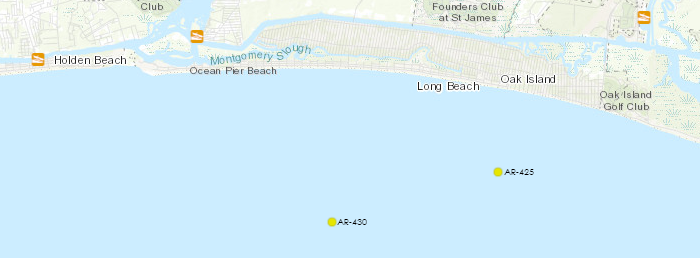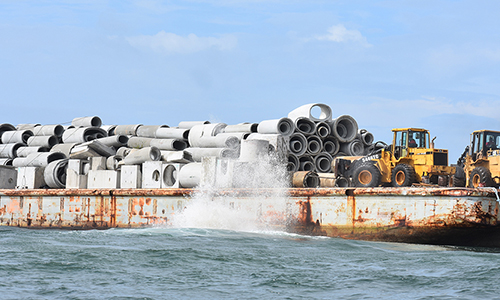
OAK ISLAND – More than 1,600 tons of concrete pipe have been added to an artificial reef to beef up recreational fishing off Brunswick County’s coast.
The new addition complements 2,000 tons of pipe placed throughout the site in 2013 and a 75-foot barge sank within the reef site in July.
Supporter Spotlight
“We have constructed a little less than half of what was proposed for this site,” said Jason Peters, artificial reef coordinator with the North Carolina Division of Marine Fisheries, or DMF.
Plans are to sink upwards of an additional 2,500 tons of concrete pipe before year’s end when the Coastal Area Management Act, or CAMA, major permit for the project and funding expire.
“It’s got to be done by then,” explained Andy Fisher, president of the Long Bay Artificial Reef Association.

Long Bay, a group of Brunswick County-based fishermen dedicated to pursuing and supporting the construction of artificial reefs, has been working with the state to create recreational fishing spots within a short distance of the coast.
“Artificial Reef – 430,” as it is identified, is one of nine artificial reefs Long Bay has worked with the state to create since the association was founded in 1984, Fisher said.
Supporter Spotlight
Sand and mud bottom close to the shoreline do not provide habitat for near-shore species like flounder, Spanish mackerel and king mackerel, popular catch among saltwater anglers.
“There’s nothing there to attract fish except in the fall, when the bait run up and down the beach and some in the spring,” Fisher said.
The state, in conjunction with Long Bay, initiated the construction of AR-430 in 2010, filing for the state and federal permits required to sink materials at the site in the hopes of creating fish habitat.
Funds for the project have come primarily from the state’s Coastal Recreational Fishing License, or CRFL, program, which requires anyone 16 and older to purchase a saltwater fishing license.
Long Bay paid the $17,000 it cost for contractors to sink the barge within the reef.
The Southport-Oak Island Area Chamber of Commerce contributed a majority of the funds – $15,000 – money generated from the annual fall U.S. Open King Mackerel Fishing Tournament, Fisher said.
AR-430 is a little less than 3 miles offshore of Oak Island and about 35 feet below the surface of the Atlantic.
“We have two reefs up near the Cape Fear River and Lockwood Folly,” Fisher said. “Those are our two heaviest fished reef sites. We wanted to have something close enough for the guys coming out of the Cape Fear and close enough for the guys coming out of Lockwood Folly.”

AR-430 rests within that desired location. It is outside of a traditional commercial fishing area, which is a requirement of the state.
“It’s on sand bottom,” Fisher said. “We also have to avoid any areas that have naturally occurring hard bottoms. In fact, we had to move this site a little to the west because it was on a naturally occurring hard bottom.”
DMF maintains more than 40 artificial reefs peppered along North Carolina’s coast. Their distance to the shore ranges from a half-mile to 38 miles. Each reef can be directly reached from a state-maintained inlet.
The division also maintains 25 estuarine reefs, 15 of which are oyster sanctuaries.
Like a majority of the state-maintained ocean artificial reefs, AR-430 spans a 1,500-foot radius and encompasses about 162 acres.
“Some of the sites are a little bit bigger than that,” Peters said.
Every couple of months, DMF receives calls from building contractors and manufacturers offering to donate leftover materials.
“Often times the material we get has never been used and it is really clean,” Peters said.
In order to create an artificial reef in state waters, or those within 3 miles of the coast, DMF must obtain a CAMA major permit and an Army Corps of Engineers general regional permit.
Some state-maintained artificial reefs have been around for decades, dating back to the 1940s, 1950s and 1960s, when fishermen would dump materials near shore to create fishing spots. That was before the state took over in the 1970s.
DMF is in the process of adding a 43rd ocean artificial reef off the North Carolina coast, this one south of Oregon Inlet off Pea Island, Peters said.
“We’re really not planning a whole lot more,” he said.
DMF is responsible for monitoring and maintaining each reef.
Hard copies of the reef guide are available at DMF offices in Morehead City, Wilmington, Washington, Manteo and Elizabeth City.







